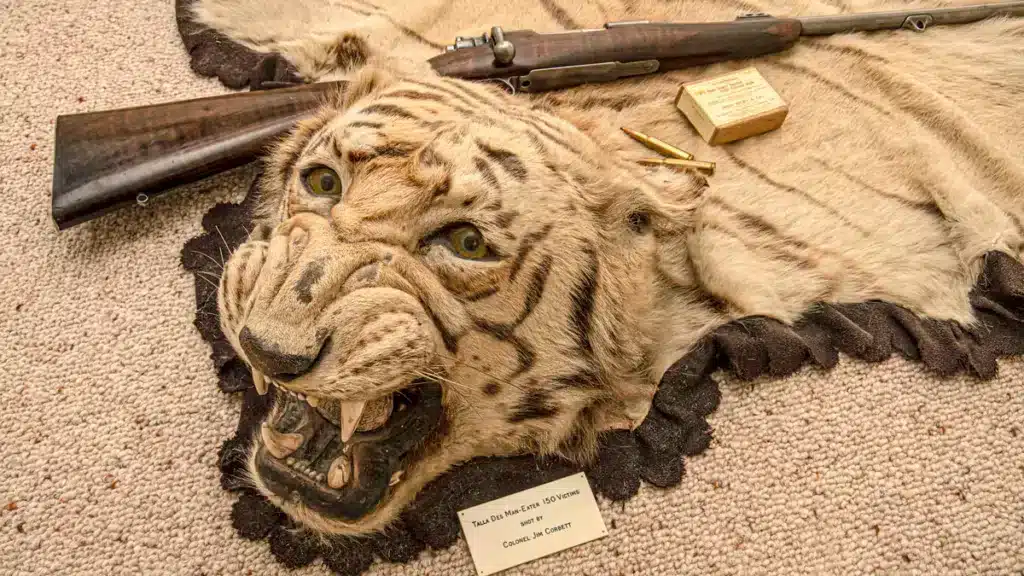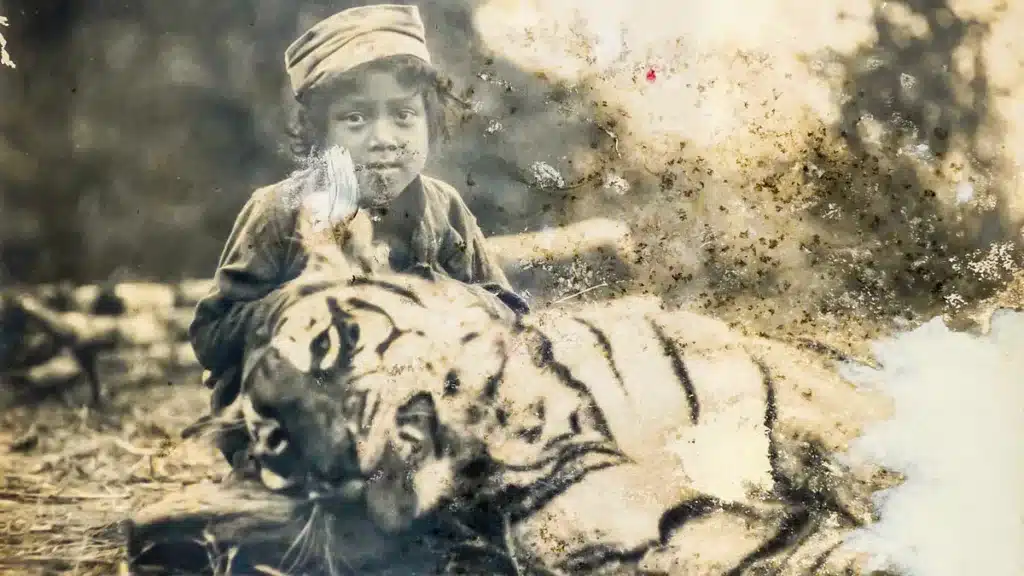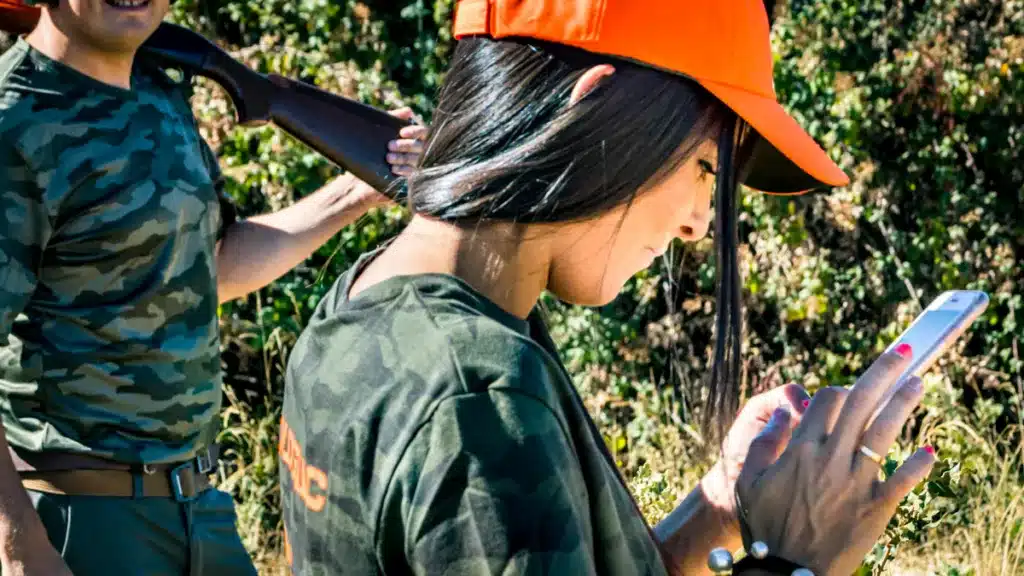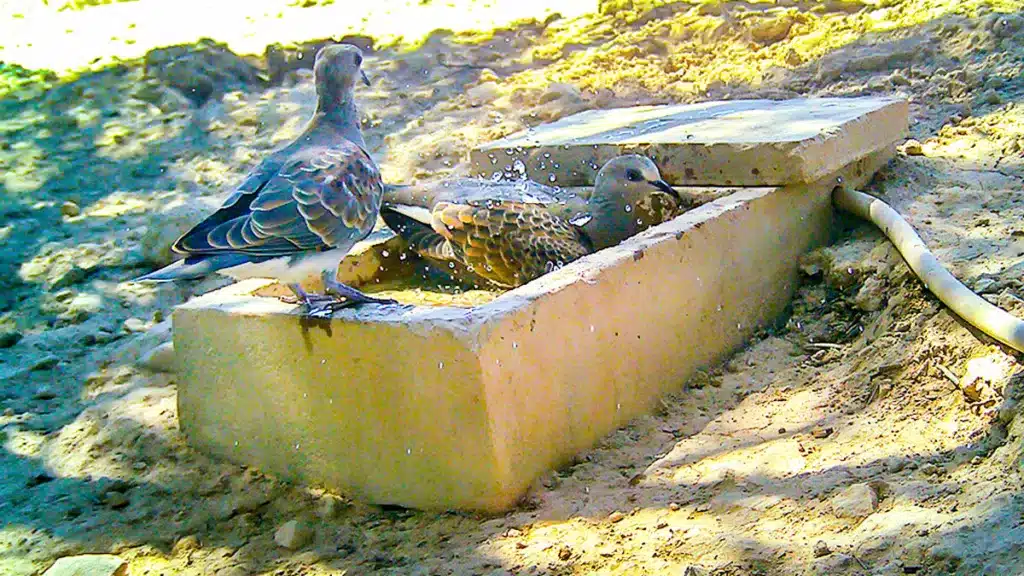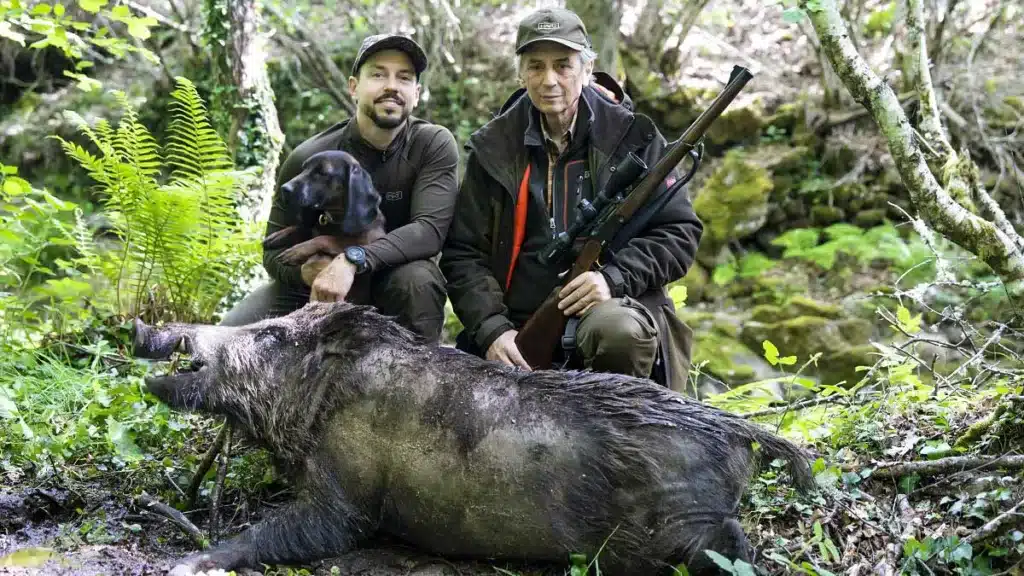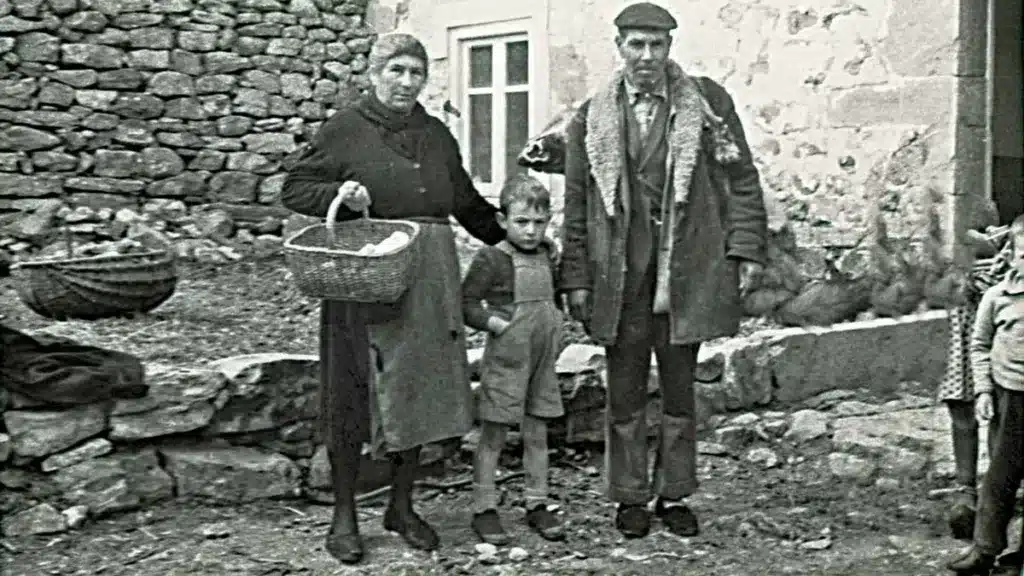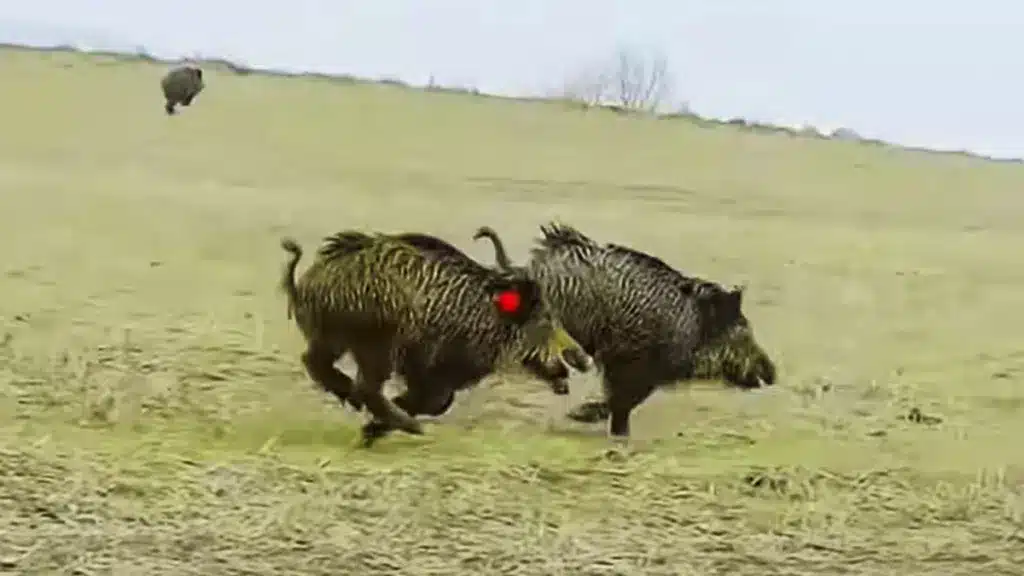Born as a child of the Raj to Anglo-Irish stock of modest means, Jim Corbett had free reign over the forests of northern India, as he grew from a boy into a teenager, fully at home under the jungle canopy and intimately familiar with the ways of the beasts and birds lurking within the greenery.
At first a sport hunter, like his more conventional contemporaries, Corbett became less inclined to hunt for the sake of it and focussed on accepting the task of shooting man-eating tigers and leopards when others had failed to do so. In doing so and later recording his reminiscences in print, Corbett became the world’s most celebrated hunter.
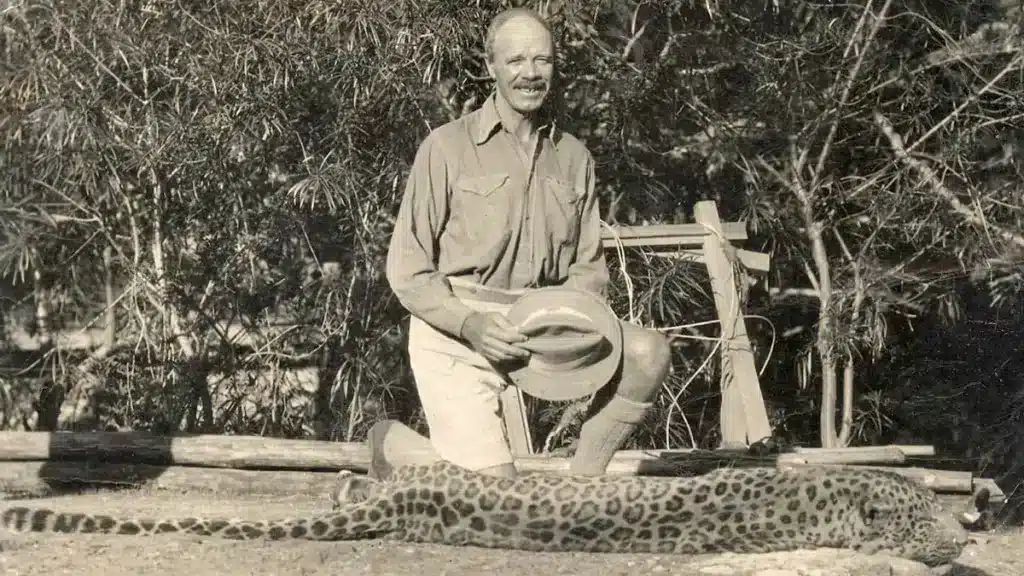
For his services he would take no fee, but insisted all other hunters vacate the area until he had succeeded in his quest. He walked great distances in arduous conditions, with few possessions and limited equipment, in his search for notorious man-eaters, many with hundreds of victims to their account.
Each time he did so, he took his life in his hands and carried the hopes and the future safety of countless villagers with him. In his hand, he often carried a Rigby rifle.
The rifle was presented to Corbett in 1907 as a token of appreciation from the authorities for his successful hunt for his first man-eater; the Champawat Tigress, a notorious man-eater, thought to have killed 436 people before meeting her end.
The history of the Corbett rifle
It was purchased from Manton & Co. in Calcutta; a company founded by a relative of the great Joseph Manton, who had apprenticed at James Purdey and Thomas Boss in the early 1800s. It became a successful store, selling the wares of most of Britain’s gun and rifle makers.
Corbett’s Rigby was a .275 (7×57) magazine rifle. Rigby records can trace it to the original order on 19th April 1905. Manton ordered ‘3 best Mauser Rigby sporting rifles, Nos. 2508, 2516 & 2517’ at a cost of £39. 6s. 0d. It was part of an order which included some second quality .275s and a .350 Mauser, as well as accessories and cases.
The .275 was bought from Manton on behalf of Sir J.P. Hewett, who had a silver oval engraved ‘Presented to Mr J.G. Corbett by Sir J.P. Hewett K.C.S.I Lieutenant Governor of the United Provinces in recognition of his having killed a man-eating tigress at Champawat in 1907.’

Corbett’s Rigby was never destined to become a ‘safe queen’, it features in many of his thrilling stories of man-eater hunts. Among those tales is that of the Talla Des man-eating tigress and her two unfortunate cubs.
Talla Des man-eating tigress reappears
Like many man-eaters, the tigress carried an injury which hampered the hunting of her usual prey, like chital and sambar deer.
She had a deep wound in her leg, caused by the penetration of porcupine quills, which are barbed and impossible to remove. She must have been in constant pain for the eight years she stalked humans, accounting for around 150 souls during her reign of terror.
For decades, nothing more was known about the Talla Des tigress than what Corbett had written in the 1940s. Then, in May 2023, Rigby received a message from a gentleman in Surrey, inside whose suburban home resided the skin of the tigress and within whose family history was some long-lost information about Jim Corbett and the fate of the Talla Des skin.
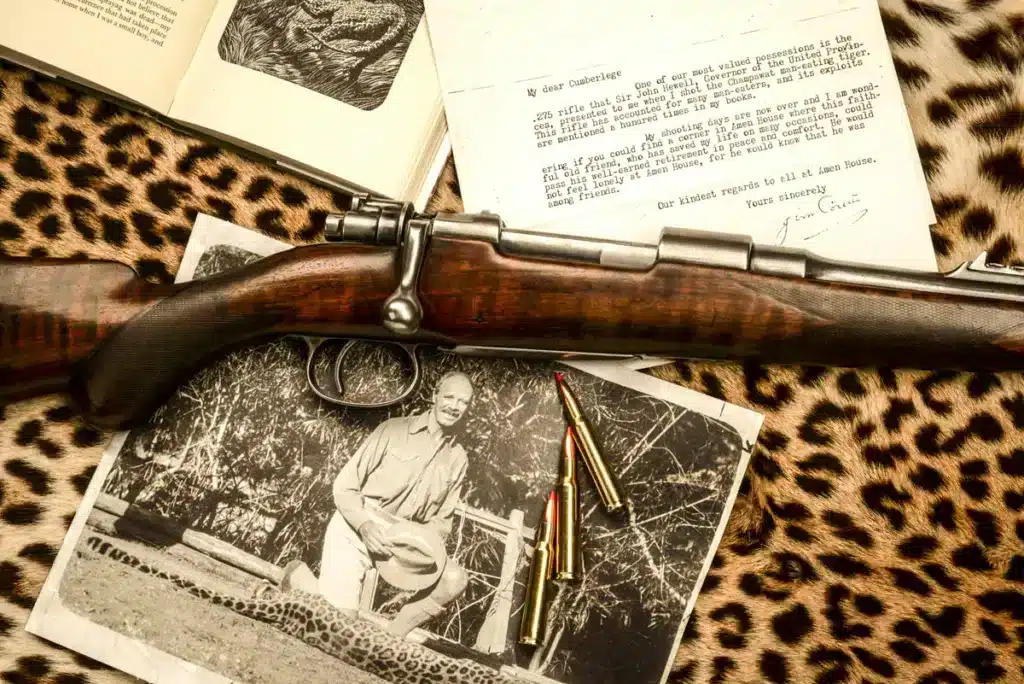
Before heading for leafy Surbiton, I re-read the story.
It was on April 4 1929 that Corbett set out for the Talla Des tigress. It took several days by train and on foot to reach the village of Talla Kote, from where he began his quest, accompanied by the son of a woman who had been eaten by the tigress, by the name of Dungar Singh.
He soon found two tigers asleep in a clearing, over which he had a good view from his vantage point on a rock outcrop. He shot the first as they slept; being unable to distinguish cub from mother at 120 yards. The second, upon hearing the shot ran up the hill and presented itself broadside, looking back at its sibling, before falling to a second shot from Corbett’s .275.
Some 25 years later he wrote ‘the cubs had died for the sins of their mother’. They had proven easy but the hunt had only just begun.
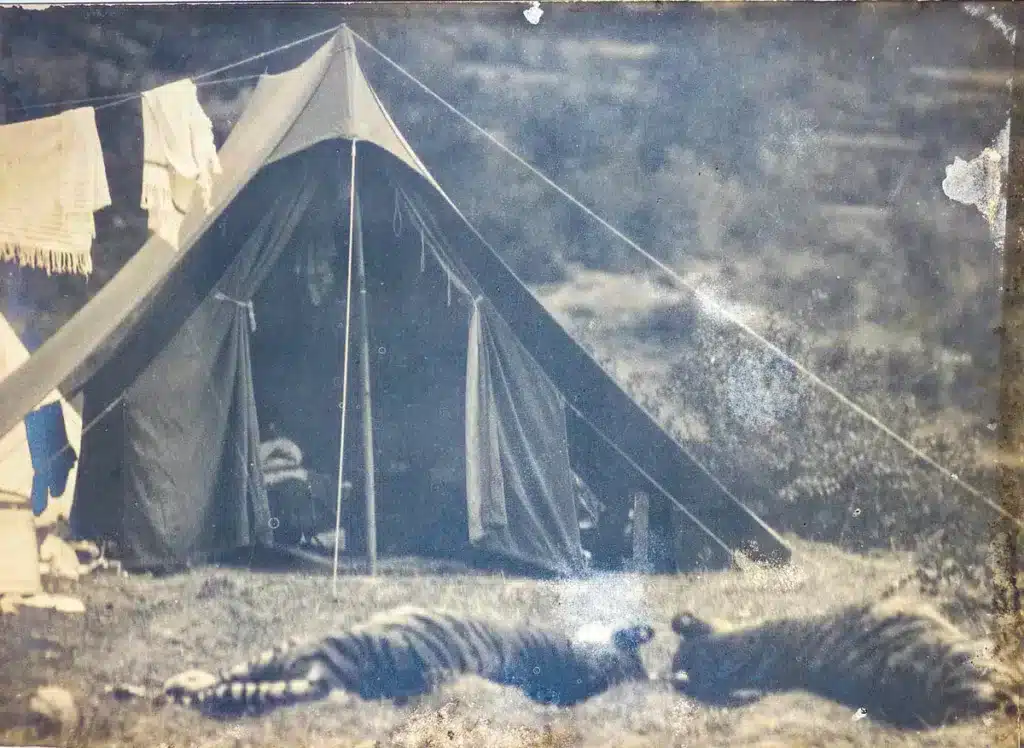
The tigress comes out of hiding
The shots flushed the tigress from where she had been resting nearby but she was 200 yards away and running. ‘I have never seen an animal fall as convincingly dead as that tiger fell at my shot’, wrote Corbett. However, events were to prove otherwise.
The dead tigress slipped down a slope until coming to rest on a sapling above a ravine. After a few minutes she fell and Corbett fired at her body as she did so, out of pure exhilaration. It seemed not to matter at the time but it left him short of ammunition; ammunition he would later need.
Walking to retrieve the fallen beast, Corbett was alerted to a presence, slowly scaling a bank 400 yards distant, clearly lame, clearly hit, but still moving. His shot missed and his rifle was empty. He could only watch as the tigress limped out of sight.
‘Madho Singh came tearing down the hill with a fresh supply of ammunition’ but it was too late. Corbett found cut hairs and a blood trail, ‘But as night was now closing in and there was not sufficient light…I decided to return to the village…’.
After two more days of arduous and dangerous tracking of the wounded tigress, Corbett found her approaching him, as he rested with his back to a tree. She lay down 100 yards from Corbett’s seat, but he could not get a clear shot and had to stalk her again when she moved on.
He continued to stalk the wounded man-eater, a terrifying prospect for a man in robust good health but Corbett was suffering from an abscess in his inner ear so severe that he felt light-headed, and his left eye was swollen so much he could not see through it.
Add to this pain, the heat, the altitude, and the fatigue of tracking in mountains for hours on end without food and you get some idea of how tough and determined Corbett must have been to continue his pursuit regardless.
Overcome with vertigo, Corbett climbed into an oak tree to rest, and it was then his abscess ruptured, venting through his left ear and nose. Corbett resumed his hunt feeling physically more able and less hindered by the infection.
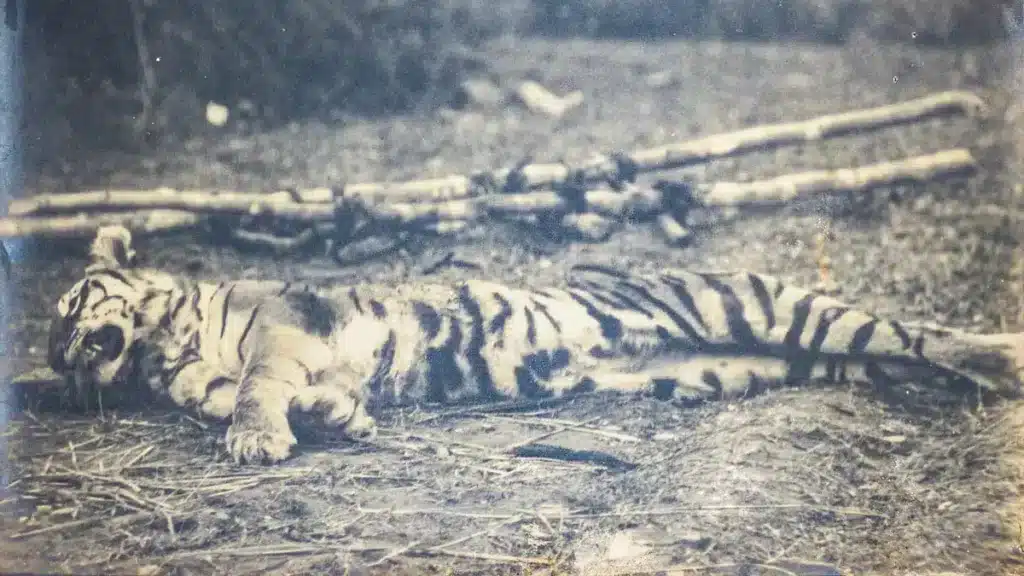
A new encounter with the tigress
A good night’s sleep allowed him to recover further and the next day he got another shot at the tigress when she presented broadside at 60 yards. Corbett’s shot was true, but the bullet passed through the animal without striking anything vital and she sprang forward and disappeared.
In his pursuit of the fleeing tigress Corbett almost launched himself over a cliff to certain death, saved only by grasping a sapling as he fell. After scrambling back to safety, Corbett checked his ammunition, ‘satisfied it was one of a fresh lot I had recently got from Manton in Calcutta’ and with a clear blood trail to follow, set off again.
He found the tigress hiding, poised to spring at him, in waist-high bracken and managed to shoot before she launched her attack, ‘my first bullet raked her from end to end and the second bullet broke her neck’.
Corbett tells us that his first shot, fired on 7 April 1929, ‘bushed’ on the tiger’s shoulder joint, the second, fired as she fell over the cliff, missed, as did the third, taken at 400 yards as she crested the hill. On April 12, his fourth shot, at 60 yards, had ‘gone clean through’ without hitting any vital organs and the fifth and sixth shots had been fatal.
So, the tigress was hit in the right shoulder, mid-body and then frontally, twice, in the neck: four bullet holes.
This is how her skin looks 80 years later
When we visited the owner to inspect the skin, which is somewhat faded but in better condition than one might expect of an 80-year-old relic that has spent part of its life in India, the bullet holes did indeed correspond with Corbett’s account of his shots. The tigress is relatively small but well mounted, in fierce, snarling pose by Van Ingen.
The owner explained that his great grandfather was born in 1875, in India, and was a civil administrator. He had returned to England in 1921 but he and Corbett, childhood friends, had remained in touch. It is likely that Corbett gave the skin to the owner’s great grandfather in the early 1940s.
Looking at the tigress, alone in an upstairs room dedicated to her repose, she is recognisable as the same beast photographed back in May 1929. There is a close-up photograph of her with the grandchild of her last victim. The clear ‘Y’ shaped stripes either side of her head are unmistakable.

Rifle and tigress meet again
We reunited the Rigby .275 with the tigress for some photographs to record the occasion. They had last met on that fateful day; 12 April 1929, when her life was ended and the villagers of Talla Kote relived of their terror.
Only one other skin of a Corbett tiger is known to still exist. That was from the Thak Man-eater, which was given to the late Henry Walck of Oxford University Press in New York after Corbett’s death.
I uncovered, in a provincial auction in 2021, some lost letters from Jim Corbett to his friend Sir William Ibbotson, among them were some photographs from several of his adventures, including images of the Talla Des tigress and her cubs.
Linking those old photographs and re-reading Corbett’s incredible story of his hunt for the tigress and now contemplating her faded skin on the floor of a Home Counties bedroom somehow condensed the last century into a few places and objects. How our world has changed.
